- Home
- Members
- I'm New-What Can I Do?
- Past, Present and Future
- Adverse Health Effects
- Freedom to Fascism film
- NRCM's CO2 - Analysis
- Ordinances/Moratoriums
- Wildlife
- Empty Economics
- Maine PUC
- Maine's Wind is Poor
- The UMPI Cover Up
- My Page
- About Us
- Contact Public Officials
- Is This ME CORRUPTION?
- Gov's Wind Task Force
- Mass vs Maine CO2
- Tourism/Property Values
- Transmission etc.
- Miscellaneous Topics
- Videos
- Photos
- BLOGS
- Supposed Enviro Groups
- Investigate Them
- New Tab
- EUT & ENR Audio Links
Electricity Emergency
America's grid is in decline and about to get far worse due to policies that:
1) reward unreliable electricity,
2) prematurely shut down coal plants,
3) criminalize nuclear, and
4) force electric vehicle use.
Here’s what’s happening and how to fix it.
A reliable grid is a foundation of our quality of life. Our lives depend on ultra-reliable electricity for the refrigerators that preserve our food, the water treatment plants that keep our water drinkable, the air conditioning that keeps us cool, the factories that produce our goods, etc.
Our grid is in an increasingly fragile state. We recently had statewide blackouts in California (2020) and Texas (2021), and shortages are occurring all around the US in 2022.
Federal Energy Regulatory Commission Commissioner Mark Christie puts it bluntly “We’re heading for a reliability crisis.”1
The root cause of our grid’s reliability problems is simple: America's power industry is politically forced is shut down too many reliable power plants, that are controlled to produce electricity as needed, in the exact quantity as needed. America's power industry is politically forced to replace those plants with unreliable, weather-dependent, intermittent, variable wind and solar.
Because wind and solar can go to near-zero at any time, using them as replacements for reliable power plants doesn’t work. For example, Texas’s February 2021 disaster was caused by solar/wind disappearing and inadequate investment in reliable power plants and their weatherization.2
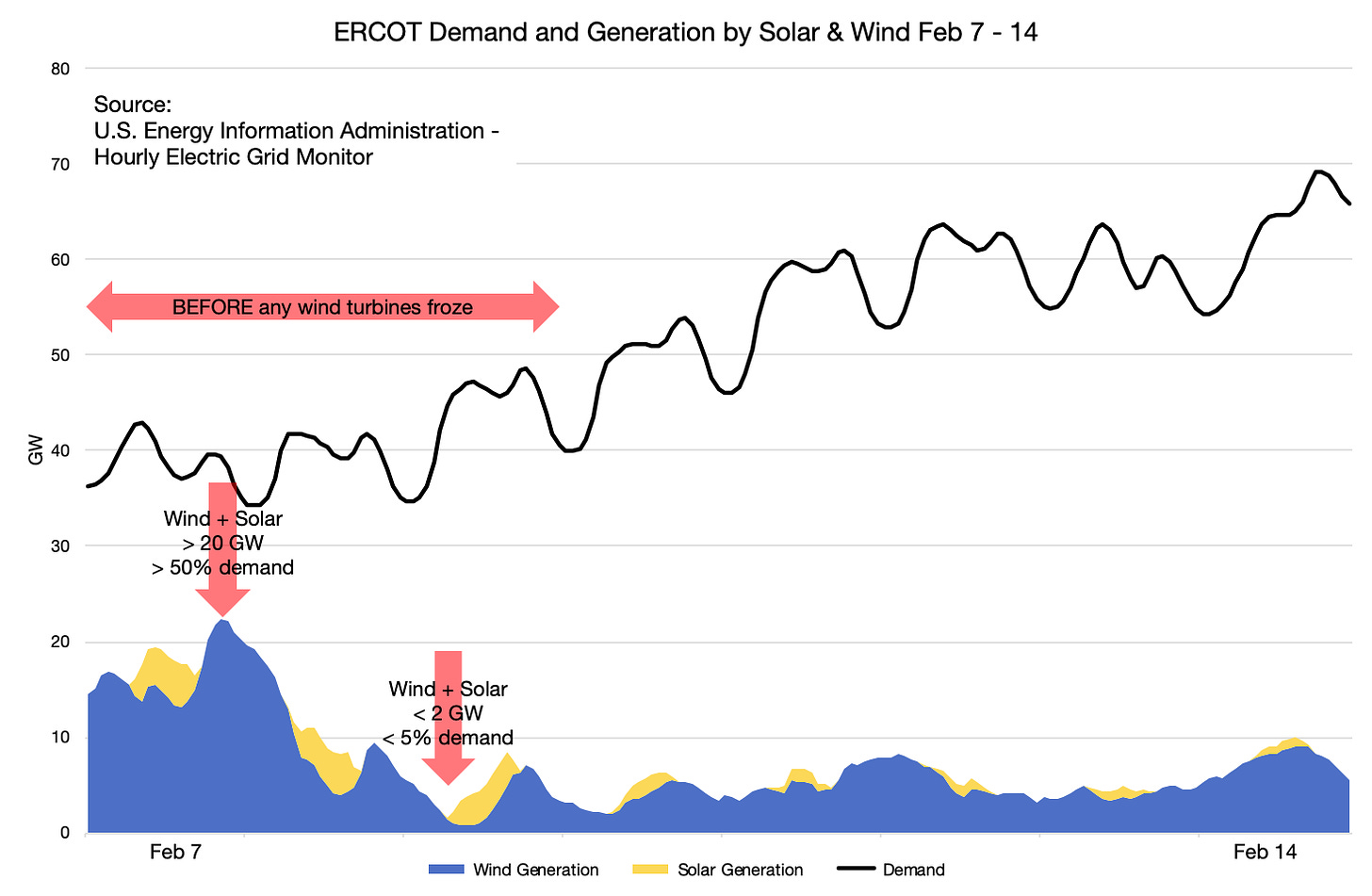 https://bucketeer-
https://bucketeer-Grid operators around the country are warning us we are retiring too many reliable power plants. MISO, the Mid-continent Independent System Operator, recently released this chart, showing a decline in “accredited capacity” “due to thermal power plant retirements” and increasing wind and solar.3
-
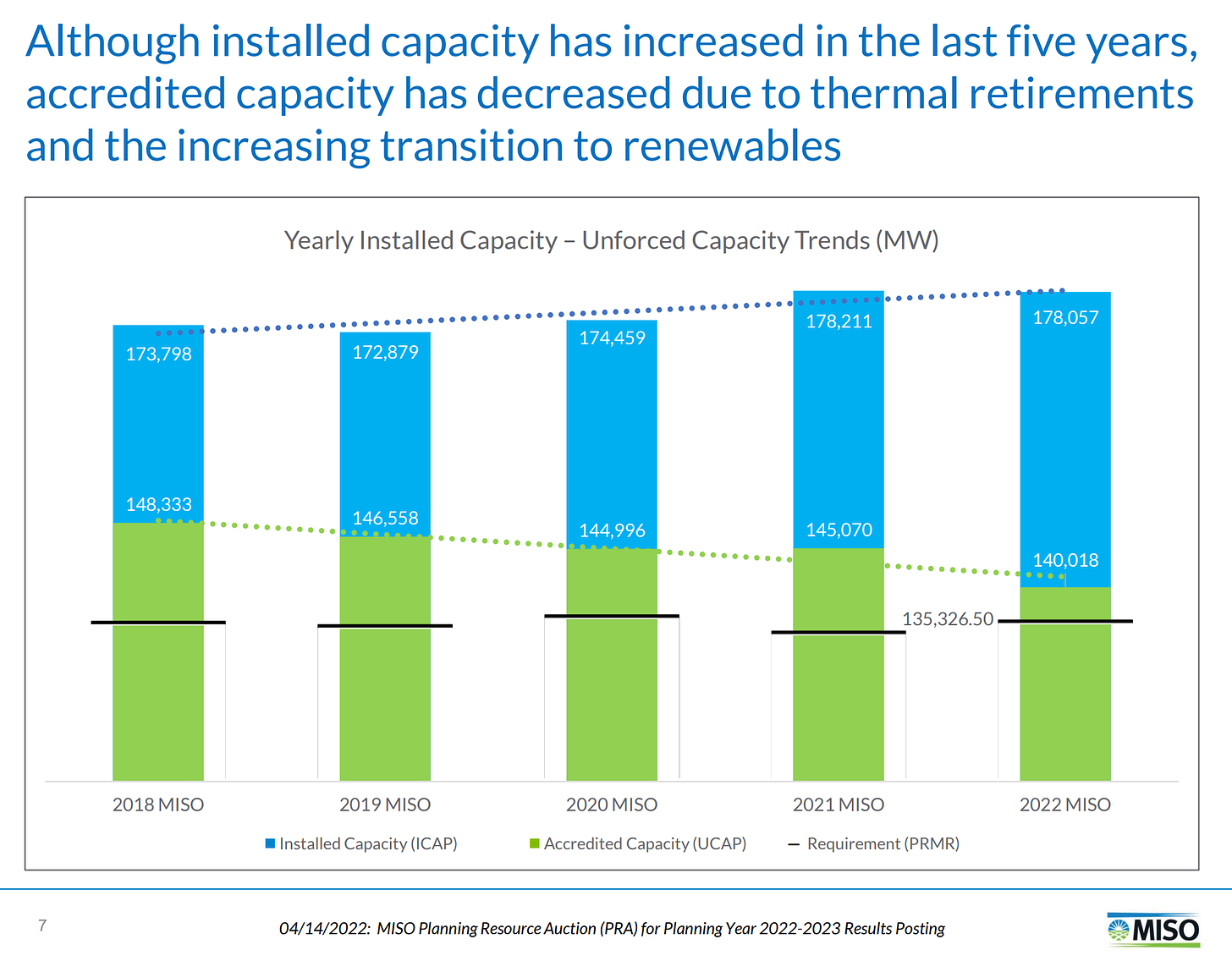 https://bucketeer-e05bbc84-
https://bucketeer-e05bbc84- Nationally, as demand has increased over the last 10 years, we have seen a decline in reliable generating capacity (gas, coal, oil, nuclear, hydro) by 5%.4
-
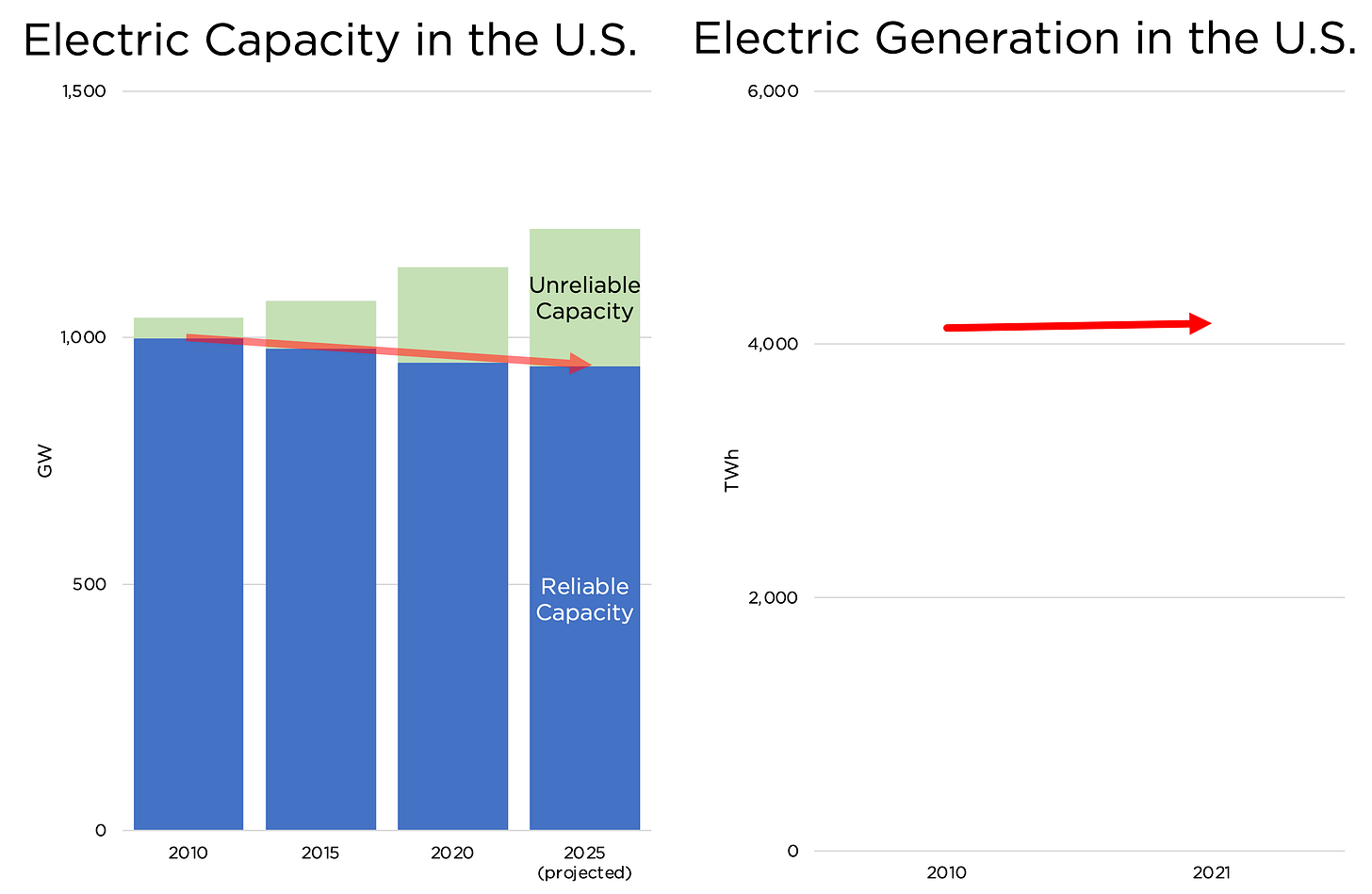 https://bucketeer-
https://bucketeer- Decreasing reliable capacity, as demand increases, is politicians playing a game of “reliability chicken”: trying to get away with minimal reliable capacity, then hoping the weather cooperates, such as:
1) Hoping electricity demand will not increase, when it is too hot or too cold
2) Hoping wind and solar supply will not decrease, when there is too little wind and sunshine.
The Feb 2021 blackouts in Texas show how dangerous “reliability chicken” can be. Texas’s grid planners hoped it wouldn’t get very cold, and that the wind wouldn’t diminish too much, so their lack of reliable generating capacity wouldn’t be exposed. They proved to the whole world hoping doesn’t work.5
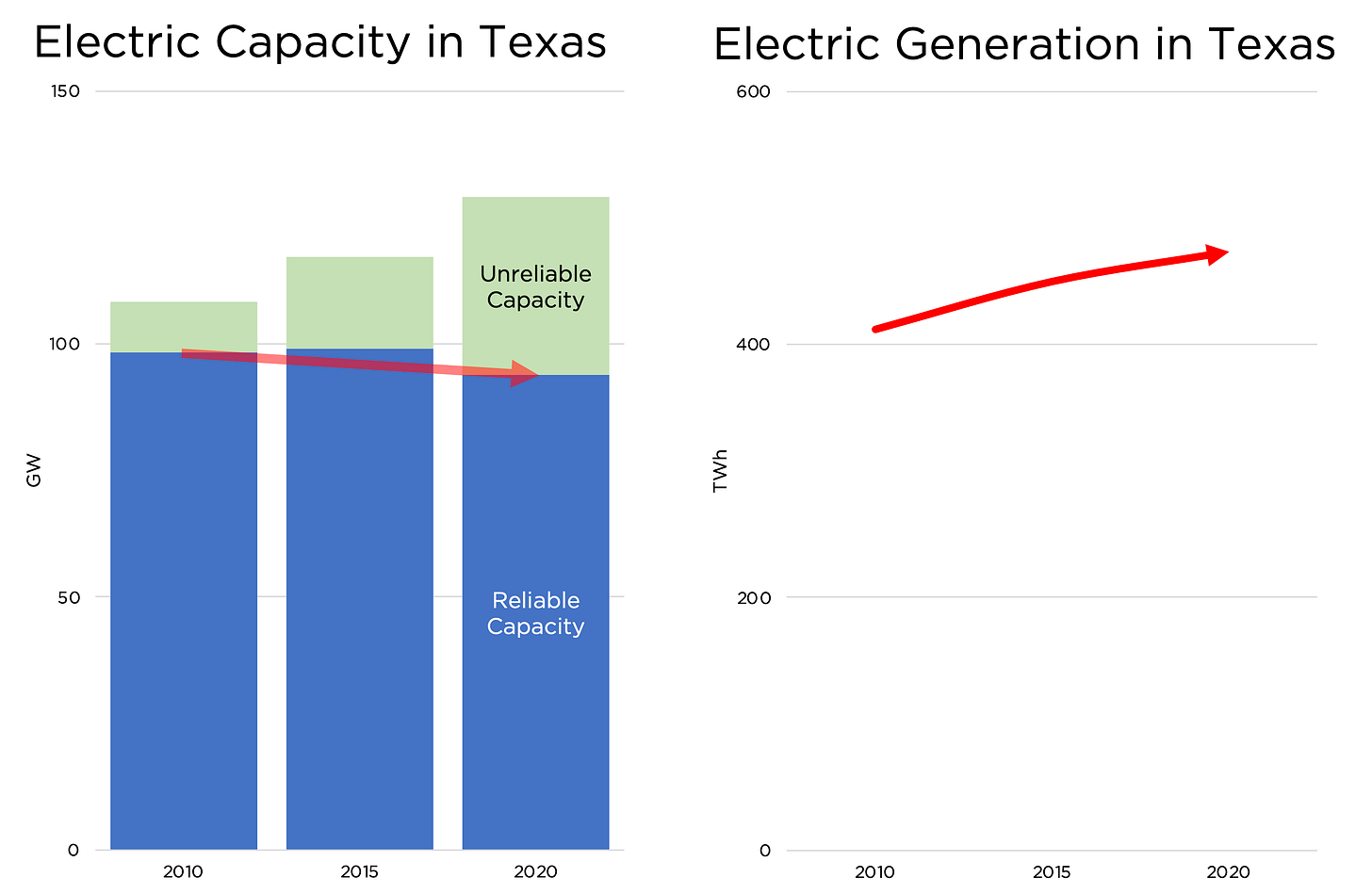 https://bucketeer-
https://bucketeer-
The 2020 blackouts in California also show the danger of inept, politicians playing “reliability chicken". Rah, Rah politicians forced the retirement of lots of in-state, reliable electric generation capacity, and hoped favorable weather conditions and imports from other states would save them. They proved to the whole world hoping does not work.6

Politicians need to recognize the reliability crisis and fight it. Instead, Biden and his posse of Energy Greenhorns are planning to make the problem far, far worse via policies that will shut down many more reliable power plants, while increasing the unreliable supply of wind and solar.
Our reliability problems are scheduled to get far worse
Looking at the publicly announced plans of utilities, which are largely determined by government policies, we are scheduled to see many more shutdowns of reliable power plants in favor of unreliable wind and solar.
This year grid operators planned on retiring about 15 GW of reliable capacity and replacing it with about 12 GW of reliable generation. Every decrease in reliable capacity worsens grid stability.7
Will batteries make unreliable wind and solar reliable? No. Battery storage is hugely expensive and can provide a given "capacity" (e.g., 1 GW) for up to FOUR hours, from fully charged to fully discharged. Planned battery system capacities (MW/MWh, are nowhere near enough to compensate for the unreliability of wind and solar.8
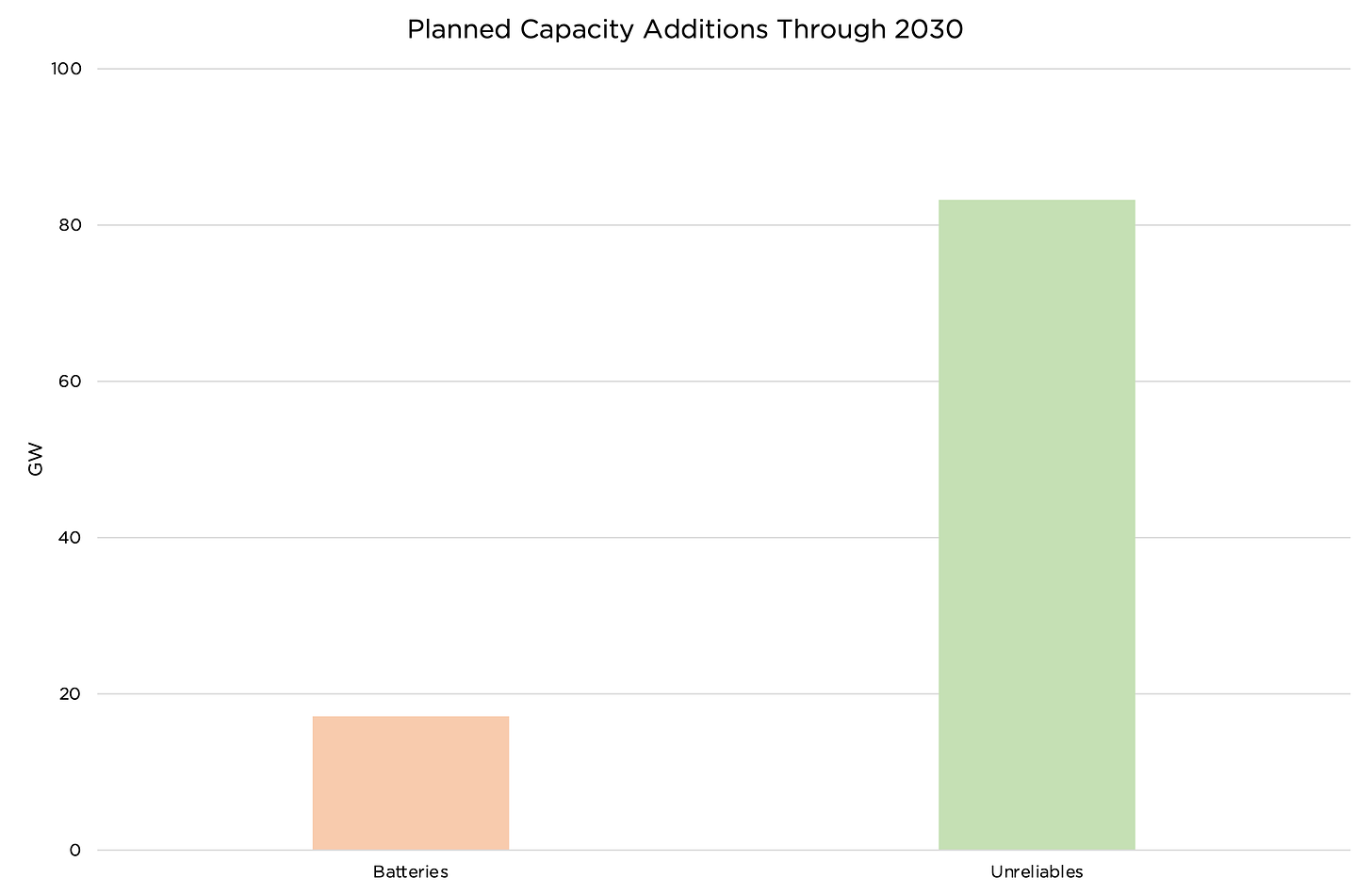
The next 7.5 years are scheduled to be a bloodbath of reliable capacity retirements.
There are 93 GW of announced coal plant retirements, plus up to 92 GW are at risk retiring early, due to new Environmental Protection Agency rules. That's almost ONE FIFTH of our already-scarce reliable capacity being shut down.9
If coal plants were replaced by plenty of reliable natural gas plants, that would be great. But utilities are not planning nearly enough gas plants to offset the likely shutdown of reliable coal plants.10
Will our rapid shutdown of coal plants that make up ONE FIFTH of our reliable capacity be offset by new nuclear plants? Not remotely. Here are the minuscule plans for RELIABLE nuclear compared to the plans for UNRELIABLE wind and solar through 2030.11
-
 https://bucketeer-e05bbc84-
https://bucketeer-e05bbc84-
To solve the reliability crisis, we must understand, and reverse the four policies turning America’s Reliable Grid into a Third-World Grid:
1) Stop rewarding unreliable electricity
2) Stop imposing ruinous Environmental Protection Agency rules on power plants
3) Stop criminalizing nuclear
4) Stop forcing electric vehicle and heat pump use
Grid-destroying policy 1: Rewarding unreliable electricity
Governments need to stop rewarding unreliable electricity by a) pricing unreliable electricity with no cost penalty, b) subsidizing unreliable generators, and c) mandating significant percentages of unreliables.
Stop pricing unreliable electricity with no cost penalty
In every area of life, we pay far more for a reliable service than for an unreliable one. But in electricity, unfair rules make utilities pay the same prices for unreliable wind and solar electricity as they do for reliables.
Grids need to recognize that unreliable electricity is fundamentally different and far less valuable than reliable electricity
One way to stop vastly overpaying for unreliable electricity is: require all generators to meet certain reliability standards.
Generators would still be able to use wind and solar, if they paid for combining it with reliables and/or storage to guarantee reliability.
At a minimum, grids must stop attributing a FAUX reliability to solar and wind—which causes them to vastly overvalue wind and solar, and make reckless plans.12
Given the unpredictability of weather and peak demand timing even a month ahead, the effective reliable capacity of wind and solar is NEAR ZERO. Even if we can expect some wind to blow somewhere in a grid area, it might be much less than expected
Stop subsidizing unreliable wind and solar
Subsidies for unreliable electricity, above all the Investment Tax Credit and the Production Tax Credit, force taxpayers to pay utilities to reduce outputs, or shut down, reliable power plants, whenever the sun shines or the wind blows.
Wind and solar subsidies are driving reliable power plants out of business, leading to higher costs and lower grid reliability.
Ominously, Biden and his posse of Energy Greenhorns recently extended the wind and solar subsidies indefinitely.
A future Congress should end wind and solar subsidies, which would reduce electricity prices + increase grid reliability.13
Another form of subsidy to eliminate: subsidizing unreliable wind and solar by socializing their costs, such as additional transmission lines or storage batteries. This socializing subsidy further rewards unreliable wind and solar, at the expense of reliables and of customers.
The combination of no penalty for lack of reliability, and special subsidies for wind and solar means, more and more reliable power plants go out of business.
Stop mandating wind and solar to be part of the energy mix
Even beyond paying a premium for unreliable electricity, many states mandate a certain percentage of solar and wind—and states are becoming more and more aggressive with those mandates. Another dire threat to grid stability.
Mandates for unreliable solar and wind, which require land and sea areas, and shut down reliable fossil fuels and nuclear, regardless of how much costs rise and reliability declines, should be ended wherever they exist.
Grid-destroying policy 2: imposing ruinous Environmental Protection Agency rules on power plants
Even though America’s coal plants provide more than ⅕ of our all-too-scarce reliable generating capacity, our government, largely through the EPA, is trying to shut down most or all of these plants in the next 7.5 years.
Coal plants today provide 215 GW of reliable capacity—down >100 GW from just 10 yrs ago due to shutdowns.
When plants were at retirement age and replaced more cheaply by gas plants, this made sense. But most coal was retired early, at great cost—and not sufficiently replaced.14
We know that the electricity crisis Texas experienced in Feb. 2021 would have been much more widespread had it not been for our fleet of reliable, resilient coal plants. As OK Gov Kevin Stitt explained: “Renewable sources…dropped to almost zero…coal was really bailing us out.”15
The Environmental Protection Agency has been the major driving force of cost-adding, reliability-reducing coal shutdowns so far. And it’s the driving reason why between 93-185 GW are expected to retire by 2030–a terrifying 9-18% of our already meager reliable capacity.16
The problem with the EPA rules that are shutting down coal plants in catastrophic numbers is that they do not employ genuine cost-benefit analysis. Most egregiously, their analyses of coal shutdowns don’t consider the cost of an unreliable grid!
Grid-destroying policy 3: Criminalizing nuclear power
Ultra-promising nuclear energy became ultra-expensive—causing numerous shutdowns of vital plants—in large part because politicians have demonized it and virtually criminalized it through endless unscientific regulations.
Nuclear energy, the cleanest and safest form of energy ever devised, has the long-term potential to outcompete fossil fuels at producing electricity and heat, and possibly many forms of transportation, as well.
Despite its amazing potential and promising track record, nuclear is stagnating and even declining in much of the world. Costs have increased as much as 10X, in large part because plants that used to take 4 years to build now take 16 years.17
And existing nuclear plants are being shut down well before the end of their useful lifetimes. Thankfully, that trend is slowing. But government is doing nothing to address the criminalization that makes new plants virtually impossible to build in any remotely affordable way.
By systematically decriminalizing nuclear energy—from eliminating the pseudoscientific ideas that justify it, to vastly speeding up the permitting process, to stopping anti-development activists who delay plants for years—America can lead a new nuclear renaissance.
Grid-destroying policy 4: coercing electric vehicle and heat pump use
At a time when reliable electricity is scarce and about to become far scarcer, the Federal government and certain state governments are trying to force us to use electric vehicles—which would lead to major increases in electricity use at certain times of day.
Electric vehicles are a valuable product for certain people but not yet cost-effective for the vast majority of us. The proper electric vehicle policy is to let EVs compete on a free market, but not in any way pressure us to use them before 1) we can afford them and 2) the grid can handle them.
Instead of letting electric vehicles compete and facilitating the increase in reliability electricity that large-scale electric vehicle use requires, the Federal and state governments are coercing us into using more EVs while destroying the grid.
The most reckless electric vehicle policy of all is California’s, which combines outlawing new oil-fueled vehicles by 2035 and wrecking its grid by shutting down reliable power plants.
As The Babylon Bee put it, “State With No Electricity Orders Everyone To Drive Cars That Run on Electricity.”18
 https://bucketeer-e05bbc84-baa3-
https://bucketeer-e05bbc84-baa3-
California is already having major problems with electric vehicle charging. On August 30, 2022, CAISO, the California grid operator, sent out a press release urging consumers to cut electricity usage during a heatwave, including using less air conditioning (!) and refraining from “charging electric vehicles.”19
Note that electric vehicle charging is a threat to the California grid while only a small share of CA’s over 30 million vehicles are electric and solar and wind are only a fraction of what they are supposed become. With less reliable power and far more EVs the situation would be catastrophic.20
Imagine if, during the California blackouts of 2020 or the Texas blackouts of 2021 these grids were both far more dependent on unreliable solar+wind andhad a massive fleet of electric vehicles that needed charging. Imagine the death toll and economic damage. That’s where our policies are taking us.
Electric vehicles should be free to compete on the free market, but should not be forced on us whatsoever. This way, they will proliferate only when 1) we can afford them and 2) the grid can handle them. Instead of being the existential risk to our grid that they are today.
Summary: Our grid is disastrously declining thanks to policies that 1) reward unreliable electricity, 2) prematurely shut down coal plants, 3) criminalize nuclear, and 4) force electric vehicle use.
By reversing these policies we can not only avert disaster but make our grid a world leader.
Comment
-
Comment by Thinklike A. Mountain on September 15, 2022 at 12:00am
-
An earthquake out of New Hampshire
https://rumble.com/v1k2k7h-episode-2152-maga-blow-out-in-new-hampsh...
-
Comment by Dan McKay on September 12, 2022 at 6:08pm
-
What started as a folly is now a crime
-
Comment by Thinklike A. Mountain on September 12, 2022 at 10:46am
-
Trump Vindicated: Germany Plays Blame Games as Merkel Party Attacked for ‘16 Years of Energy Policy Failure’
https://www.breitbart.com/europe/2022/09/12/trump-vindicated-german...
U.S. Sen Angus King
Maine as Third World Country:
CMP Transmission Rate Skyrockets 19.6% Due to Wind Power
Click here to read how the Maine ratepayer has been sold down the river by the Angus King cabal.
Maine Center For Public Interest Reporting – Three Part Series: A CRITICAL LOOK AT MAINE’S WIND ACT
******** IF LINKS BELOW DON'T WORK, GOOGLE THEM*********
(excerpts) From Part 1 – On Maine’s Wind Law “Once the committee passed the wind energy bill on to the full House and Senate, lawmakers there didn’t even debate it. They passed it unanimously and with no discussion. House Majority Leader Hannah Pingree, a Democrat from North Haven, says legislators probably didn’t know how many turbines would be constructed in Maine if the law’s goals were met." . – Maine Center for Public Interest Reporting, August 2010 https://www.pinetreewatchdog.org/wind-power-bandwagon-hits-bumps-in-the-road-3/From Part 2 – On Wind and Oil Yet using wind energy doesn’t lower dependence on imported foreign oil. That’s because the majority of imported oil in Maine is used for heating and transportation. And switching our dependence from foreign oil to Maine-produced electricity isn’t likely to happen very soon, says Bartlett. “Right now, people can’t switch to electric cars and heating – if they did, we’d be in trouble.” So was one of the fundamental premises of the task force false, or at least misleading?" https://www.pinetreewatchdog.org/wind-swept-task-force-set-the-rules/From Part 3 – On Wind-Required New Transmission Lines Finally, the building of enormous, high-voltage transmission lines that the regional electricity system operator says are required to move substantial amounts of wind power to markets south of Maine was never even discussed by the task force – an omission that Mills said will come to haunt the state.“If you try to put 2,500 or 3,000 megawatts in northern or eastern Maine – oh, my god, try to build the transmission!” said Mills. “It’s not just the towers, it’s the lines – that’s when I begin to think that the goal is a little farfetched.” https://www.pinetreewatchdog.org/flaws-in-bill-like-skating-with-dull-skates/
Not yet a member?
Sign up today and lend your voice and presence to the steadily rising tide that will soon sweep the scourge of useless and wretched turbines from our beloved Maine countryside. For many of us, our little pieces of paradise have been hard won. Did the carpetbaggers think they could simply steal them from us?
We have the facts on our side. We have the truth on our side. All we need now is YOU.
“First they ignore you, then they laugh at you, then they fight you, then you win.”
-- Mahatma Gandhi
"It's not whether you get knocked down: it's whether you get up."
Vince Lombardi
Task Force membership is free. Please sign up today!
Hannah Pingree on the Maine expedited wind law
Hannah Pingree - Director of Maine's Office of Innovation and the Future
"Once the committee passed the wind energy bill on to the full House and Senate, lawmakers there didn’t even debate it. They passed it unanimously and with no discussion. House Majority Leader Hannah Pingree, a Democrat from North Haven, says legislators probably didn’t know how many turbines would be constructed in Maine."
https://pinetreewatch.org/wind-power-bandwagon-hits-bumps-in-the-road-3/
© 2025 Created by Webmaster.
Powered by
![]()
You need to be a member of Citizens' Task Force on Wind Power - Maine to add comments!
Join Citizens' Task Force on Wind Power - Maine